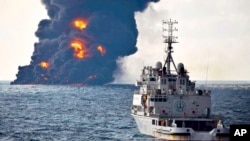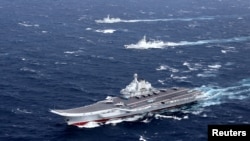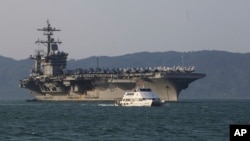China is expected to hold its first joint military exercises with a group of Southeast Asian nations later this year.
China and the 10-member Association of Southeast Asian Nations, or ASEAN, agreed to the exercises during a meeting in Singapore last month.
Singapore’s defense ministry released a statement at the meeting. It said ASEAN defense ministers “welcomed” the chance to hold maritime exercises with China. The joint exercises are expected to happen before the end of 2018.
Experts say the goal of the exercises is to train naval forces from countries operating in the South China Sea to deal with possible conflicts and avoid accidents. They would also work to develop a code of conduct that aims to set rules to keep the sea safe for shipping.
ASEAN members and China are still working on final language for the code of conduct, which could be completed this year.
Six governments have competing claims in the South China Sea, which acts as a pathway for one third of the world’s shipping traffic. China claims about 90 percent of the sea as its territory and often sends coast guard ships throughout the waterway.
China has also been building up man-made islands in the South China Sea in recent years – some of which support military structures. The expansion has angered other nations which also have territorial claims in the area.
But clashes and shipping accidents in the South China Sea are rare. Military experts say one reason for this is the development of a code of conduct. Competing nations also use widespread surveillance and have learned to watch out for one another.
One part of the joint exercises is expected to involve a simulation of a conflict situation in the South China Sea.
Philippine Defense Secretary Delfin Lorenzana recently suggested the exercises might start out with a “table top” exercise. This usually describes an operation that simulates emergencies but does not involve sending ships to sea.
Carl Thayer is a Southeast Asia expert with the University of New South Wales in Australia. He says the exercises should be a chance to let different countries exchange skills in fighting fires and rescuing people after boat crashes.
He added that the joint operation can be a good way for military officials to build trust in case they ever come across each other in a possible clash at sea.
“Theoretically, in a crisis or unexpected situation you have that kind of trust already, that people do know who they’re dealing with. So that’s always seen as an important part militarily and ships even more so because they’re isolated rather than units on the ground.”
Thayer says China sees the exercises as the beginning of more long-term military cooperation with ASEAN nations in the future.
The U.S. does not claim any part of the South China Sea. But it has sent ships to the area to carry out “freedom of navigation” exercises. Such operations are meant to show military force and support free movement of shipping in international waters.
Jonathan Spangler is director of the South China Sea Think Tank in Taipei. He says a joint military exercise involving claimants in the South China Sea would mark an important step in developing relations. But he believes resolving the complex territorial issues is more of a long-term problem.
"It all depends whether or not China and ASEAN can keep up the positive momentum," Spangler said. "Because the underlying disputes have not been resolved yet, that may prove difficult in the long run.”
I’m Bryan Lynn.
Ralph Jennings reported this story for VOA News. Bryan Lynn adapted it for Learning English. Mario Ritter was the editor.
We want to hear from you. Write to us in the Comments section, and visit our Facebook page.
_______________________________________________________________
Words in This Story
maritime – adj. of or related to the sea
surveillance – n. intelligence gathering
simulation – n. something made to look, feel, or behave like something else
isolated – adj. separate from others
momentum – n. the strength or force that allows something to continue or to grow stronger or faster over time













